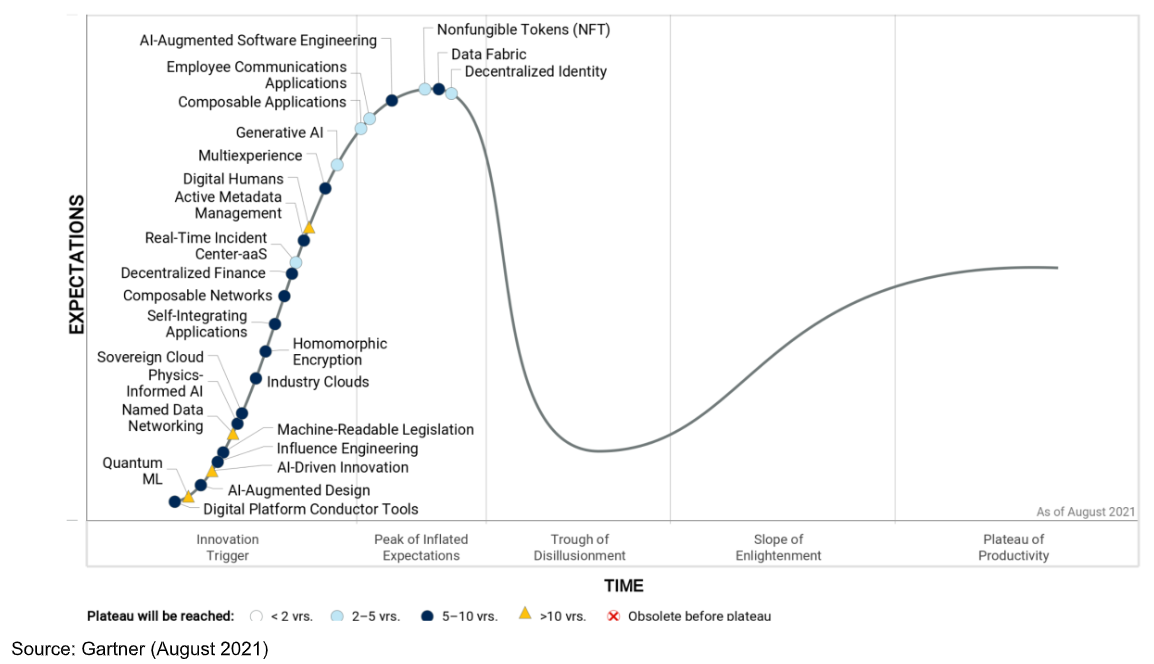 EMERGING TECH
EMERGING TECH
 EMERGING TECH
EMERGING TECH
 EMERGING TECH
EMERGING TECH
Research firm Gartner Inc. has identified engineering trust, accelerating growth and sculpting change as the three main trends driving organizations to explore a range of new and emerging technologies it has identified in its latest Hype Cycle.
The 2021 Gartner Hype Cycle For Emerging Technologies report, released today, highlights the rise of nonfungible tokens or NFTs, sovereign cloud, data fabric, generative artificial intelligence and composable networks, among other technologies it says can help organizations to secure a competitive advantage.
The Hype Cycle is meant to help enterprises distill insights from more than 1,500 emerging technologies into a succinct set of “must know” trends that Gartner believes show a lot of promise in helping to deliver a “high degree of competitive advantage” in the next five to 10 years.
The concept of “engineering trust” revolves around the idea that trust demands both security and reliability and can be extended to build innovations as a resilient core and foundation to deliver business value, Gartner says. To deliver this foundation, it’s necessary to engineer repeatable, trusted, proven and scalable working practices and innovations.
Gartner explains that the cloud and digital technology services market is currently dominated by U.S. and Asian providers. As such, many European firms are forced to store their data in these regions. But that leads to political unease and concerns over the retention of data control.
To achieve digital and data sovereignty, companies can engage with emerging “sovereign clouds” that give them complete control over the data that resides within them, preventing third parties, including the cloud providers, from having access or being able to compromise it. In turn, that will create the legal requirements to apply data protection controls, residency requirements, protectionism and intelligence gathering.
Gartner said sovereign cloud is one of a number of technologies to watch that will support engineering trust, along with NFTs, machine-readable legislation, decentralized identity, decentralized finance, homomorphic encryption, active metadata management, data fabric, real-time incident centers and employee communications apps.

The “accelerating growth” trend is perhaps more obvious, but it involves the need to balance technology risk carefully with the appetite for business risk to ensure near-term objectives can be attained. Once engineering trust is established, companies will be able to accelerate growth to extend delivery and value, Gartner said.
One example tech that will enable this is generative AI, which makes it possible for machines to use things such as text, audio files and images to create entirely new content. The pharmaceutical industry is already using cutting-edge generative AI models to reduce costs and time in drug discovery, Garter said. By 2025, it predicts, more than 30% of all new drugs and materials will be discovered systematically using generative AI.
“Generative AI will not only augment and accelerate design in many fields; it also has the potential to ‘invent’ novel designs that humans may have otherwise missed,” Gartner said.
Gartner also recommends exploring multiexperience, industry cloud, AI-driven innovation, quantum machine learning and digital humans technologies to accelerate growth.
Change has traditionally always been seen as something that’s disruptive and chaotic for businesses, like the move to the cloud was. But Gartner says that will change in the future with the rise of the principle of “sculpting change,” which involves first anticipating and then auto-tuning a business to the needs of whatever changes are coming.
Composable business applications, for example refers to apps that are built from interchangeable business blocks. The idea with this modular approach is that it helps a business to rearrange and reorient as needed depending on external or internal factors, such as a shift in customer values or sudden change in supply chain or materials.
Gartner said it’s a prime example of a technology that will allow businesses to sculpt change to fit their needs by recognizing and exploiting new business opportunities, responding to unexpected disruptions and meeting customers’ changing demands at their own pace.
Other technologies that seem primed to enable sculpting change include composable networks, AI-augmented design and software engineering, physics-informed AI, influence engineering, digital platform conductor tools, named data networking and self-integrating applications.
Gartner Research Vice President Brian Burke said it’s important for organizations to understand that breakthrough technologies are continually appearing, challenging even the most innovative companies to keep up with the pace of change.
“Leading organizations will lean on the emerging technologies in this year’s Hype Cycle to build trust and new growth opportunities against a background of continued strategic change and economic uncertainty,” he said.
THANK YOU